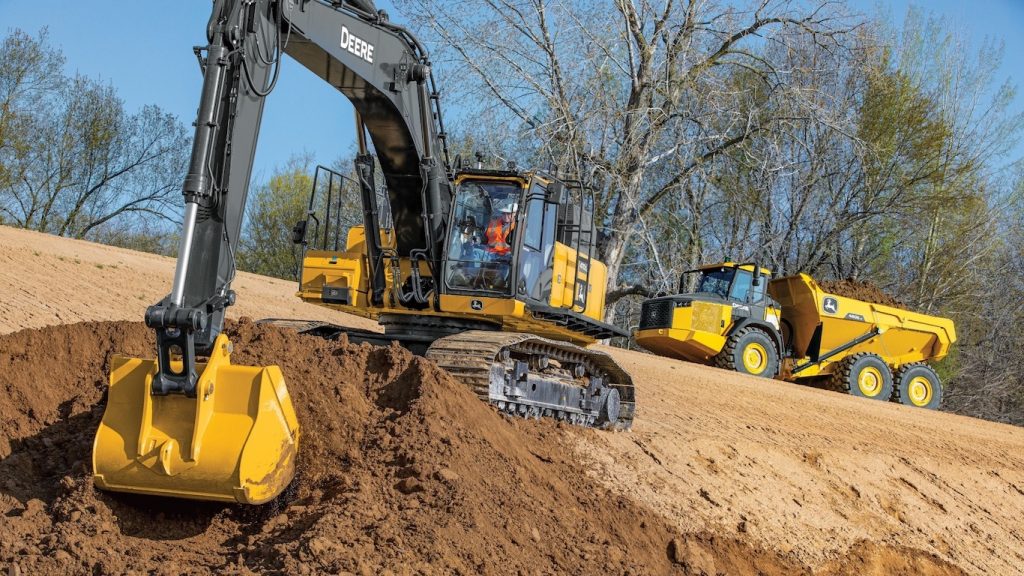John Deere 590 Excavator Head Gasket Problems and Solution: A blog about common John Deere excavator problems and how to solve them.
Removing the john deere 590 excavator head
You can easily remove the john deere 590 excavator head. It’s not a hard job to do and will not take you much time. The first step is to check the engine oil and coolant levels. They should be full in order to make sure that you won’t break anything during the process of removing the head on your john deere 590 excavator.
After you’ve checked that the engine oil and coolant levels are full you should start your engine up and make sure it runs smoothly. If there are any issues that need to be taken care of before removing the head, now would be a good time to address them. You don’t want any problems getting in your way when trying to get this thing off!
Once everything looks good it’s time for some fun! Grab onto both sides of the valve cover with one hand each (this makes it easier if someone else holds them while you’re taking pictures). Make sure they’re lined up evenly before turning them counterclockwise until they come loose from their seats.

Cleaning the john deere 590 excavator head and engine block surfaces
The following information provides general cleaning instructions for the head and block surfaces of John Deere 590 Excavator. If necessary, consult a John Deere service manual or the engine manufacturer’s website for more detailed instructions.
The following steps outline the process that we used to clean the head and block surfaces of our John Deere 590 excavator. You should adjust it as needed to suit your needs.
1) Remove all gaskets from the head and block surfaces using a razor blade. Use caution not to gouge or scratch the metal surface.
2) Scrape all carbon deposits from the piston crowns, cylinder walls, intake valves, exhaust valves, valve seats, valve guides and combustion chambers using a razor blade scraper.
3) Clean all surfaces using a wire wheel on an angle grinder or drill motor with wire brush attachment. A power washer can also be used to help remove any remaining carbon deposits and dirt. Wire wheel on an angle grinder Drill motor with wire brush attachment Power washer
4) Using 600 grit wet/dry sandpaper, sand all metal parts down to bare metal if they are free of rust or corrosion. Allow any parts that have surface rust or corrosion to remain as-is in order to.
Inspecting and checking the john deere 590 excavator cylinder block surfaces
Using a straightedge and feeler gauges, check the cylinder block main bearing bore for straightness and alignment. Check the crankshaft main journal for out-of-roundness or taper.
The maximum allowable out-of-roundness of the main bearing bore is 0.0015 inch (0.038 mm).
Check the flatness of the engine mounting surface on the cylinder block with a straightedge and feeler gauges. The maximum allowable deflection is 0.004 inch (0.102 mm).
Check the cylinder bore for taper and out-of-roundness with a dial indicator at 25 degrees intervals around the bore. The maximum allowable taper is 0.003 inch (0.076 mm). The maximum allowable out-of-roundness is 0.001 inch (0.025 mm) at any point in the bore.
Checking the john deere 590 excavator valves and valve seats
The john deere 590 excavator is a big machine and there are a lot of moving parts. This includes the valves and valve seats, which are critical for both engine power and fuel efficiency.
The 590 has two main pump assemblies. The primary pump assembly is located under the operator’s seat and contains all of the pump-driven accessories, such as the water pump, oil cooler system, air conditioning compressor, hydraulic pumps and hydraulic valves; it also houses the fuel tank. The secondary pump assembly is located below the boom in the rear of the vehicle.
Checking the john deere 590 excavator injector bores
Maintaining the john deere 590 excavator injector bores is a very important job for any owner of the tractor. The tractor is not a cheap machine and if it breaks down it can cost a lot of money to fix. If you let it sit for too long then it will start to wear down and eventually break.
When checking the injector bores make sure that they are not clogged up. If they are then you will need to clean them out by putting some oil down into the bores and letting it sit overnight. This will help remove any debris that may have got stuck in there and prevent any more damage from happening.
After cleaning out your injector bores make sure that you lubricate them with some lubricant so they don’t rust or get damaged again. You should also check the spark plugs at this time as well because sometimes these can get damaged from being overfilled with fuel which can cause problems later on down the road.
Checking the john deere 590 excavator fuel pump housing
1. Open the hood and disconnect the negative battery cable using an adjustable wrench.
2. Remove the fuel tank cap to relieve the pressure in the system.
3. Locate the fuel filter on the right side of the engine compartment, near where it connects to the main fuel line. The filter housing looks like a small canister with a screw-on lid at one end and connects to two hoses, one on either side of it, with hose clamps.
4. Loosen and remove the hose clamps using a screwdriver, then slide them off of each hose so you can lift out the fuel filter housing.
5. Pull straight up on the lid of the filter housing to remove it from its base, then lift out and discard the old filter inside it by pulling it straight up out of its place in the housing base.
Installing the john deere 590 excavator head gasket
In this video, we show how to install a John Deere 590 excavator head gasket. The procedure is the same for all of the JD excavators from 80 to 450. The steps are as follows:
1. Remove all of the hoses connected to the engine and air conditioning system.
2. Drain all of the coolant from the radiator.
3. Disconnect the battery cables and remove the battery.
4. Remove all of the vacuum lines and wiring harnesses connected to the engine compartment that might get in your way during disassembly or reassembly.
5. Remove all 6 head bolts, starting with number 2(the one farthest away from you). Note which bolt locations had washers on them for reassembly later on.
